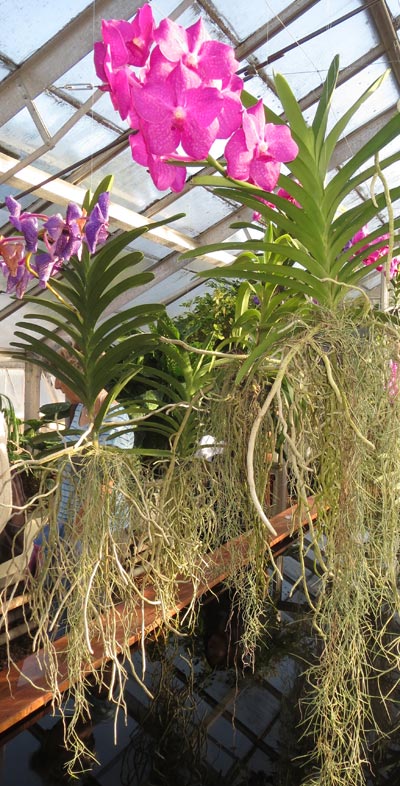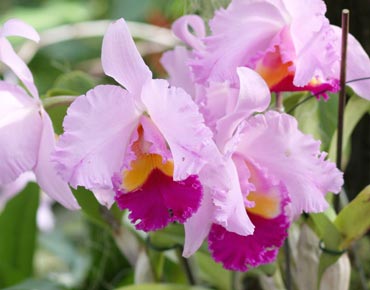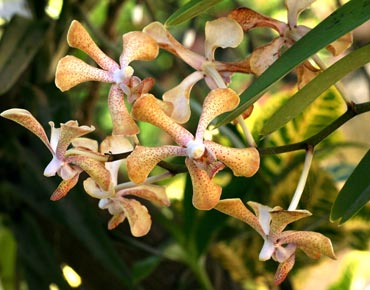


Vanda orchids have some of the most attractive, and long lasting flowers of all members of the orchid family; a characteristic that has made the Vanda orchid one of the most popular amongst orchid lovers and florists worldwide. Vanda orchid care varies on how they are potted: hanging Vanda orchid care is different from terrestrial (ground) Vanda orchid care. Vanda orchids can grow very large, and in general are not the easiest for an orchid beginner. Anyone attempting to keep them must exhibit due care: orchids as houseplants will require similar conditions to those in the rainforest canopy. Large plants need to absorb lots of moisture through their roots whilst basically remaining dry, and this is not always easy to replicate in your home. But with a little attention and care, Vanda orchids can reward you with beautiful blooms over and over.
Vanda is just one of many genera in the orchid family Orchidaceae. Individual species names will follow the word Vanda, i.e. Vanda coerulea, the famous blue Vanda; though this is often shortened to V. coerulea. The genus has significant variation, with over 80 different species naturally occurring. The Vanda orchids for sale are typically hybrids, developed by orchid growers for their stunning flowers. The plants available in larger home and garden stores are generally quite hardy, and make good starter specimens.
 Vanda orchid plants should be grown in a manor approximating their natural habitats, with roots trailing down. Photo Malcolm Manners
Vanda orchid plants should be grown in a manor approximating their natural habitats, with roots trailing down. Photo Malcolm MannersWild Vanda orchids grow in tropical climates, Eastern Asia and Northern Australia, including India (the name Vanda actually derives from the Indian language Sanskrit), Sri Lanka, Indonesia, Bhutan, Myanmar, Borneo, the Philippines, New Guinea, southern China and the Himalaya region. These species typically occur in warm, moist rainforests; a fact worth remembering when attempting to keep these plants in our homes.
Many Vanda orchids are epiphytic (they grow on other plants, typically trees, high in the forest canopy), but you can also find lithophytic (root in cracks in rocks) and terrestrial (ground growing) species. Finding out which type of orchid you are keeping is important, as this will determine the care they require. Vandas grow from a single stem (monopodial), with leaves growing alternately from either side. You can determine whether your Vanda orchid is a tree-dwelling epiphyte, or a terrestrial plant by the shape of these leaves: a circular cross section (terete) indicates a terrestrial plant. A 'U' or 'V' shaped leaf (strap leaf) indicates an epiphyte. And there is good reason for this difference. Truly epiphytic species have to survive some very extreme conditions: during certain parts of the year rainforests can experience huge, prolonged rainfalls; other times, the only moisture is that which is in the air, and this is where the specific leaf shape is so useful. Any droplet of water falling onto a strap leaf is channelled directly to the plants roots. You can often find Vanda orchids for sale (but not in nature) with a third leaf style: hybrids of epiphytic and terrestrial Vanda have semi-terete leaves; plants with requirements somewhere between the two naturally occurring types.
 Hanging Vanda orchids at Cambridge University botanic garden. The bare rooted Vanda are suspended over a pool of water, creating enough moisture to allow these plants to thrive. Photo David Short
Hanging Vanda orchids at Cambridge University botanic garden. The bare rooted Vanda are suspended over a pool of water, creating enough moisture to allow these plants to thrive. Photo David Short
As explained above, in nature, epiphytic varieties of Vanda typically attach themselves to the branches of trees, with their roots trailing down below them. As they have no moisture-holding substrate, they absorb water from the atmosphere through their aerial roots. To care for orchids indoors, we can attempt to replicate these conditions. The roots need to absorb lots of water, but must never be allowed to sit for long periods in wet conditions; really good ventilation, is critical. So by far the easiest way to care for orchids indoors is to hang them in a pot, or slatted basket, with no media - perhaps a small amount of coconut husk fiber or osmunda to retain a little moisture in dryer environments.
The baskets can be plastic, but they look far more natural in wood. The basket will typically have an open-slat construction, with plenty of room for roots to grow out, be open enough to allow good ventilation, and have no means of trapping water to prevent the roots from remaining wet after watering. There are some great wooden Vanda baskets here.
Vanda can also be kept in ceramic or glass containers, again with no media; the plants is purely supported by the root ball below it. Pots may be typical flower pots, or special Vanda pots with holes around the sides. Roots grow into the shape of the container, and have more or less ventilation, depending on the size of the pot and the amount of roots. Care has to be taken not to permit the roots to sit in any water, but as there is no planting medium, this is easy to check.
Epiphytic Vanda orchids can be potted, but they are a more challenging plant when kept this way. They should be potted using a loosely-packed coarse medium that does not retain water, such as fir bark. Insufficient ventilation in the roots and leaves can result in leaf and root decay. Generally a few stones are also useful, to give the plant pot extra stability. It is generally best to use a clear plastic pot with ventilation holes, which can of course be placed into a larger ceramic pot for increased stability. This allows examination of the roots, and ensures the plant is not over-watered. Remember, silver roots mean the plant should be watered, green roots mean it should not.
Epiphytic and lithophytic Vanda orchids absorb huge amounts of water from the atmosphere, and in the wild encounter rain storms that may last for days. But take care; orchids are naturally very sensitive to over-watering, and even the terrestrial species will hurt if you leave them “with their feet wet”.
Actually, getting adequate moisture to larger bare rooted plants (and Vanda can grow large) can be problematic. Vanda grown over a pool can absorb evaporating air - perhaps even over an open-topped aquarium, or in a humid plant room. Plants can also be grown in large terrariums with precisely controlled humidity, and complicated misting systems. But how do we care for orchids indoors - in a typical home or greenhouse?
If you have a bare-rooted Vanda orchid, whether hanging, or in a Vanda pot, watering is simple. You know when the plant needs watering, simply by looking at the roots; if they are a silver color, the orchid requires water. For small Vanda orchids, it may be sufficient to mist the plants roots. For a larger hanging Vanda, dip-watering is more appropriate: simply unhook the basket and place the entire rootstock of the plant into a suitable container of water. Tap water seems to be fine in most cases. After 10-15 minutes the plant can be removed and rehung. The roots will have turned a light green color. This process should be repeated whenever the plant requires it - but typically every morning, or even twice each day during hot conditions. After watering, the well ventilated roots have the rest of the day to dry out.
Potted Vanda will not require watering as often, perhaps once every 3-4 days. Always let the potting medium dry out thoroughly before you water again.
As these plants come from the tropics, it is best to care for orchids indoors, or in a heated greenhouse (unless you have live in a particularly warm climate). The optimal daytime temperatures for Vanda orchids is fairly warm: between 75-85˚F (24-29˚C). Night should temperatures can range between 65-75˚F (18-24˚C). It is best to have this day/night variance, as this mimics the conditions found in the natural Vanda orchid habitats. The plant can tolerate slightly somewhat lower temperatures, but the closer to it's natural conditions, the happier the plant will be. Actually many of the commonly available hybrids available in garden centers are quite adaptable plants. Of course, any healthy and well established Vanda orchid can cope with occasional temperature swing; even the rainforest has cooler days, but obviously these should be minimised.
An important aspect of Vanda orchid care is providing your plant with sufficient amounts of light. Vanda orchids need a lot of sun light, but should be protected from intense mid-day sun, which can scorch leaves. Again there is a difference between the epiphytes, which tend to grow within the partial shade of their host tree, rock-growing lithophytes, and terrestrial plants that occur in full sun in rainforest clearings, typically after trees or branches have fallen. Ideally place your plant in a spot where it can enjoy full morning and afternoon sun while being partially shaded from 11am to 3pm. Vanda leaves turning yellow indicate over-exposure to strong sunlight, while dark green leaves indicate that your orchid needs more sun. Strive to keep the leaves light green. Insufficient light will also impede flower growth. Keep an eye on your Vanda's leaves.
 A wonderful display of hanging Vanda plants. Photo Michael Adams
A wonderful display of hanging Vanda plants. Photo Michael Adams
It is important to take care of orchid feeding; the correct nutrients are essential for leaf growth, and to encourage flowering. But when to fertilize orchids? Vanda orchids do require regular fertilizing especially during the growing season (spring and early summer). The best fertilizer for orchids is a high-nitrogen, liquid fertilizer (I like Orchid Love which can be added to the plants water, either when dip-watered or misted. If the plant enters a dormant period, no fertilization is required, otherwise feed bimonthly in winter. Sufficient feeding can do wonders for growth, and encourage your orchid bloom more than once per year.
Over fertilization can certainly cause damage to the plant, with wilting leaves being one sign. To reduce the chance of overdosing, ensure no residues of previous feeds are trapped within the plants basket or pot.
Do not disturb your Vanda orchid by repotting it too often. Wait until the orchid has outgrown its old pot before you re-pot. This will typically take 2-3 years during normal circumstances.
One important aspect of Vanda orchid care is repotting. When the roots of hanging Vanda plants become constricted by their basket, it is time to remove and re-pot. The old basket is best cut away - carefully of course, to cause as little disturbance to the roots as possible. Dry, dead roots can be removed. The plant can then be simply placed in a nest of coconut fiber within the new basket.
As with bare-root Vanda, planted specimen should also be repotted every few years, again taking care not to damage roots. In some cases, the potting medium should however be exchanged immediately. Never let your Vanda orchid grow in a potting medium that has gone sour, has any sign of mould, or is unable to drain properly.
It is impossible to remove the old basket without causing some minor root damage. This is not a big problem, roots do grow back, but it can stress the orchid: Vanda should only be repotted when completely necessary.
Vanda flowers are impressive to say the least. The range of colors, shapes and patterns are absolutely wonderful. Flower spikes emerge from the central stem and poke out between the leaves. The show from one Vanda spike can sometimes last up to eight weeks or more, and this is naturally a highly desirable treat in the floral industry. If you a Vanda plant with ideal Vanda orchid care, it can bloom more than once a year.
 Vanda "Wild Cherry" photo Maja Dumat
Vanda "Wild Cherry" photo Maja Dumat Vanda orchid photo Maja Dumat
Vanda orchid photo Maja Dumat Vanda orchid photo Paolo Marco Mañalac
Vanda orchid photo Paolo Marco Mañalac Vanda coerulea (the blue orchid) growing at Singapore Orchid garden photo Sue Waters
Vanda coerulea (the blue orchid) growing at Singapore Orchid garden photo Sue Waters A wonderful yellow Vanda at the American Orchid Society botanical garden, Florida. Photo Marcy Hargan
A wonderful yellow Vanda at the American Orchid Society botanical garden, Florida. Photo Marcy Hargan Vanda tricolor var. suavis
Vanda tricolor var. suavisSome of the interesting, rare and not-so-rare Vanda orchids for sale
A small selection of notable Vanda species: